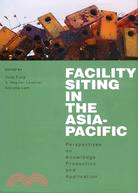Facility Siting in the Asia-Pacific:Perspectives on Knowledge Production and Application
- ISBN13:9789629964061
- 出版社:香港中文大學出版社
- 作者:FUNG; Tung‧LESBIREL; Hayden S. & LAM; Kin-che (eds.)
- 裝訂/頁數:精裝/292頁
- 出版日:2011/07/01
再享89折,單本省下136元
商品簡介
作者簡介
S. Hayden Lesbirel is Associate Professor and Coordinator of political science in the School of Arts and Social Sciences at James Cook University. He specializes in the political economy of policy formulation and implementation and has a particular interest in energy and environmental affairs and policy in Japan and in the Asia-Pacific.
Kin-che Lam is Professor in the Department of Geography and Resource Management and Director of the Institute of Environment, Energy and Sustainability at The Chinese University of Hong Kong. He specializes in environmental impact assessment and environmental policy.
序
Tung Fung and Kin-che Lam
All societies require a full array of facilities to provide services and support for
societal development. While some of these facilities may be greeted warmly by
local communities, others are less welcome and are increasingly being rejected
by those communities. This phenomenon is often referred to as Locally
Unwanted Land Uses (LULUs) and the Not In My BackYard (NIMBY)
dilemma. Facilities such as power plants, hospitals, highways, prisons, waste
treatment facilities, landfills, incinerators, chemical waste disposal, and treatment
plants are in demand in the Asia-Pacific region. The need for these facilities
is of little dispute among citizens, particularly at the national level. While
planners and decision makers need to determine where to locate these facilities,
it has become an increasingly daunting task.
While such projects can bring significant gains to both local and national
communities, the negative spillover effects, including environmental, social,
economic, and health impacts imposed on the local communities are often
insurmountable. More often than not, local communities raise serious
concerns that often lead to protest and opposition. This can result in project
delays, increased developments costs, and even cancellation of projects.
Certainly, local communities are vulnerable to the risks associated with facility
siting and the challenge for decision makers is to find ways to provide sound
communication, effective assessment, and management of the risks involved.
The mismatch between who gains and who loses from the development
of projects leads to conflict and, hence, the siting of projects requires a conflict
resolution process. The success of this process often rests on the ability
of promoters to build up trust and equity in a situation where there is considerable
tension amongst the interest groups. Different countries and governments
have attempted a variety of methods for facilities siting, with some
2 | Facility Siting in the Asia-Pacific
adopting a more “decide-announce-defend” approach, while others attempt a
more voluntary siting approach. Independent of the approach, there have
been varying degrees of success, and cases of failure, in particular, draw
intense media attention and can exacerbate the problem. Evidence from the
Asia-Pacific suggests that the siting problem has emerged independent of the
form of government or level of economic development of nations in the
region. The inability to manage conflicts in a timely fashion has serious implications
for the achievement of national and regional policy priorities.
Research on facilities siting has both academic merit and practical relevance
to various stakeholders. Since the 1980s, there has been a significant
growth in the literature that deals with the origins and management of
conflicts involved in siting facilities that are perceived to be public “nasties.”
This book adds to the literature in three ways. First, it evaluates the extent to
which a focus on siting in the Asia-Pacific can enhance our knowledge of
siting theoretically and comparatively. Much of the facility siting literature
originates from experience in North America and Europe. Many of the books
on siting continue to focus on Western experience, although there have been
some works on Asian experience (mainly in Japan and Taiwan). This book, by
explicitly focusing on Asia-Pacific experience and covering countries such as
China, Singapore, and Vietnam that have not been covered adequately in the
literature, seeks to make a major contribution to the growing comparative
siting literature. Second, it explores the extent to which the literature provides
insights to policy practitioners involved in managing siting disputes. The
siting literature is highly policy-relevant. Criticisms of bringing policy relevance
back into social science do not hold up in the case of siting. Yet, ironically,
there is little analysis on how the literature can assist policy makers in
developing better siting policies and effectively managing siting conflicts.
Third, it explores the scope of the subject matter covered by the siting literature.
Much of the literature makes two critical assumptions. The first is that it
presumes the only conflicts that matter are those involved between host
communities and developers, whether they be private or public or some
combination. The second is that it assumes the siting issue ends during the
preconstruction stage. This book challenges both assumptions and stresses the
importance of neighbouring communities in siting conflicts and the need to
consider postconstruction conflicts, both of which can have significant implications
for siting processes and outcomes.
S. Hayden Lesbirel, in the next chapter, provides the first extensive survey
of the siting literature since the mid-1970s and focuses on the relationship
between the production and use of knowledge in facilities siting. It suggests
that the siting literature has developed into a fully fledged literature that uses a
Introduction | 3
full range of theoretical and methodological approaches to explore siting
conflicts, and has produced a variety of middle-range theories to explain the
origins and management of those conflicts. The literature is highly policyrelevant
and can provide not only important conceptual insights to siting
practitioners in terms of basic perspectives and orientations, but can also offer
instrumental insights in strategic and functional terms. The challenge for the
literature in the future will build on these achievements and address several
theoretical and empirical shortcomings in ways that seek to fulfil the needs of
siting practitioners.
In chapter 3, Kunreuther examines ways to better manage the transboundary
risks associated with LULU. By understanding the nature of the
problem from different stakeholders, this chapter suggests a framework for
evaluating alternative siting strategies. It also explores how a siting authority
could achieve consensus-building and examines the role of mitigation
measures and compensation in the process. It then suggests a set of issues that
need to be addressed regarding the involvement of the interaction among
policy makers, risk management institutions, and the public in dealing with
transboundary risk problems facing the public and private sectors.
Mitchell in chapter 4 focuses his discussion on the relationship between
unwanted facilities and the concept of environmental justice. The ways in
which governments in North America have interpreted and used environmental
justice as one means to address issues related to LULUs and NIMBYs
are examined. Furthermore, by examining examples in Canada, approaches
(both traditional and voluntary) used in the siting process of LULUs are also
explored. The chapter specifically identifies the importance of transparent
principles, engagement of local communities from the outset in the decision
process, innovative procedures (reverse Dutch auction), and opportunities to
overcome mistrust.
LULUs certainly include a variety of facilities. Although a casino may not
be a typical NIMBY example, the introduction of a casino into any society is
controversial, as one would easily debate on the potential economic gain and
job opportunity created versus the negative externalities and social costs.
Quah and Toh in chapter 5 discuss this issue based on two casinos in Singapore
and provide a forceful argument on the importance of public goods
provision.
With few investigations on broader patterns by which authorities locate
LULU facilities, Aldrich in chapter 6 calls for a reorientation of scholarship on
land-use conflict to better capture methodological advances in the social
sciences, including large-scale data analysis and political geography to bridge
the knowledge gap. The new analytical tools uncover the strength of local
4 | Facility Siting in the Asia-Pacific
networks and social capital in the siting process. The paper concludes that
civil society has an important role to play in determining the success of implementing
new technologies, and thus highlights the importance of local
communities’ characteristics in determining which policy tools states use and
their likely effectiveness in siting.
Following on from these conceptual developments in siting analyses,
Chiou in chapter 7 examines which factors contribute to effective siting of
large-scale projects in Taiwan. The study reveals that siting syndrome emerges
in the field of Taiwan’s site selection and construction of electric power
stations and solid waste incinerators. Chiou calls for greater sensitivity towards
the influence of noneconomic factors on siting process rather than placing too
much attention on the effect of economic factors, which he believes has traditionally
been the case in the literature. Noneconomic factors in the context of
Taiwan are associated closely with the lack of public participation, credibility
deficiency, and local politics. The chapter suggests that planners should use
the community-governance approach to resolve the dilemma of siting facilities,
with more emphasis on noneconomic factors.
Moving from Taiwan to Hong Kong, Lam et al. in chapter 8 attempt to
determine how the public views LULU facilities and whether its perception of
risks is related to the type of facility. The chapter elucidates how NIMBYism
has arisen in the specific political, social, economic, and geographical context
of Hong Kong and explores how siting conflicts might be resolved. The study
also indicates that despite the concentration of LULUs in Tuen Mun, a district
with a disproportionate share of these projects, local residents are not keenly
aware of these facilities. This paper also argues that monetary compensation is
of limited effectiveness in reducing public resistance.
With inadequate enforcement of environmental regulations by the
authorities, community-driven regulation (CDR) or informal regulation is an
alternative measure used to resist public facilities, such as landfills, after they
are sited. In chapter 9, Nguyen and Maclaren examine four landfills in
Vietnam that experienced significant opposition from local communities and
assessed the measures taken by the local communities and the effectiveness of
CDR. The importance of social cohesion, social capital, and their relationship
is also discussed. This chapter indicates that a more formal mechanism is
needed to involve the public in siting and operation of noxious facilities to
avoid community opposition in Vietnam.
By focusing on benefits rather than risks that could be brought by
hazardous facilities, voluntary siting is preferred over traditional, more coercive,
methods. Baxter in chapter 10 evaluates factors leading to the success of
voluntary siting. The chapter explores the case of Swan Hills, Alberta, Canada,
Introduction | 5
which is often portrayed as one of the earliest and most successful cases of
voluntary siting in North America. However, he points out that siting cannot
claim to have achieved justice as Swan Hills was not in a disadvantaged or
vulnerable bargaining position. In fact, the perceived fairness of the original
siting process is the strongest predictor of facility-related concern, both in the
host and neighbouring communities. Implications for the viability of voluntary
siting, the appropriate role for informed consent, and the associated role
of scale are also discussed.
Ishizaka et al. in chapter 11 analyze factors relevant to the acceptance and
risk perception of landfill site for municipal soil waste in Okayama city, Kurashiki
city, and Yoshinaga city in Japan’s Okayama prefecture. The study reveals
that risk perceptions and trust in technology and standards are factors that
influence the acceptance of landfills; while trust in technology and standards,
and trust in response to accidents are the factors affecting the risk perception.
The study reconfirms the importance of an open-door policy and daily
communication between citizens and local government in the siting process.
In chapter 12, Shaw and Huang investigate siting a low-level radioactive
waste repository in Wu-chiu, and find the way in which the compensation is
provided. Fairness, trust in the developers, siting procedures, and income are
important factors characterizing the public’s perception of and attitudes
toward the facility, while trusting in negotiators is the key way residents can
make their decisions in Taiwan. The result is compared with cases in the
United States, Switzerland, and Japan. The chapter also identifies differences
among the cases in relation to social capital, including civic duty, social pressure,
and trust in the developers. It concludes that social capital is an important
aspect of public opinion in relation to the NIMBY phenomenon.
Yang, in chapter 13, studies the emergence of environmental nongovernmental
groups in siting NIMBYs in China. Based on two cases, this chapter
concludes that, given the rapid economic development and adoption of more
open and transparent policy, environmental nongovernmental groups are able
to exert their influence by stressing environmental rights and social justice,
leading to a postponement of a key hydroelectric development in Nujiang and
the resiting of a chemical plant in Xiamen.
By exploring siting problems in the context of the relationship between
the knowledge production and use in the Asia-Pacific, this book suggests
expanding the literature’s subject matter to more fully incorporate the impact
of neighbouring communities and post-siting conflicts on understanding the
origins and management of siting outcomes. Doing this will enhance the
conceptual and instrumental utility that the literature offers to stakeholders
involved in siting processes not only in the Asia-Pacific but elsewhere as well.
目次
1 Introduction 1
Tung Fung and Kin-che Lam
2 Facility Siting: The Theory-Practice Nexus 7
S. Hayden Lesbirel
3 Procedures for Dealing with Transboundary Risks in
Siting Noxious Facilities . 33
Howard Kunreuther
4 LULUs, NIMBYs, and Environmental Justice . 57
Bruce Mitchell
5 Are Casinos NIMBYs? 85
Euston Quah and Raymond Toh Yude
6 Power to the People! Civil Society and Divisive Facilities . 115
Daniel P. Aldrich
7 Site Selection of LULU Facilities:
The Experience of Taiwan 141
Chang-tay Chiou
8 Challenges of Managing NIMBYism in Hong Kong . 169
Kin-che Lam, Wai-ying Lee, Tung Fung, and Lai-yan Woo
viii | Contents
9 Community-Driven Regulation, Social Cohesion,
and Landfill Opposition in Vietnam . 183
Nguyen Quang Tuan and Virginia Maclaren
10 Reassessing the Voluntary Facility-Siting Process for a Hazardous
Waste Facility in Alberta, Canada 15 Years Later . 215
Jamie Baxter
11 Structural Model of Risk Perception on Landfill Site for
Municipal Solid Waste 231
Kaoru Ishizaka, Yasuhiro Matsui, and Masaru Tanaka
12 Compensation in Siting Hazardous Facilities:
A Radioactive Waste Repository in Taiwan 243
Daigee Shaw and Te-hsiu Huang
13 NIMBY: Environmental Civic Society and
Social Fairness in China . 257
Yang Yan
14 Conclusion . . . . . . . . . . . . . . . . . . . . . . . . . . . . . . . . . . . . . . . . . . . . . 273
S. Hayden Lesbirel
主題書展
更多主題書展
更多書展本週66折
您曾經瀏覽過的商品
購物須知
無庫存之港版書籍,將需向海外調貨,平均作業時間約30個工作天,然不保證確定可調到貨,尚請見諒。
為了縮短等待時間,建議您將港書與一般繁體書籍分開下單,以獲得最快的取貨速度。
為了保護您的權益,「三民網路書店」提供會員七日商品鑑賞期(收到商品為起始日)。
若要辦理退貨,請在商品鑑賞期內寄回,且商品必須是全新狀態與完整包裝(商品、附件、發票、隨貨贈品等)否則恕不接受退貨。

























